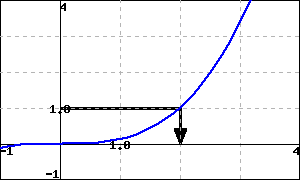Skip to main content
Contents Dark Mode Prev Up Next \(\newcommand{\definiteintegral}[4]{\int_{#1}^{#2}\,#3\,d#4}
\newcommand{\indefiniteintegral}[2]{\int#1\,d#2}
\newcommand{\lt}{<}
\newcommand{\gt}{>}
\newcommand{\amp}{&}
\definecolor{fillinmathshade}{gray}{0.9}
\newcommand{\fillinmath}[1]{\mathchoice{\colorbox{fillinmathshade}{$\displaystyle \phantom{\,#1\,}$}}{\colorbox{fillinmathshade}{$\textstyle \phantom{\,#1\,}$}}{\colorbox{fillinmathshade}{$\scriptstyle \phantom{\,#1\,}$}}{\colorbox{fillinmathshade}{$\scriptscriptstyle\phantom{\,#1\,}$}}}
\)
Appendix A Hints, Answers, and Solutions
1 Instructive Examples 1.1 Arithmetic
Checkpoint 1.1.1 . Adding Single-Digit Integers.
Checkpoint 1.1.2 . Declaring a Problem Seed.
Checkpoint 1.1.3 . Controlling Randomness.
Checkpoint 1.1.4 . Special Answer Checking.
Answer . Solution .
We
add the exponents as follows, while including a gratuitous reference to the quadratic formula:
\begin{equation*}
\begin{aligned}
{x^{5}x^{3}}\amp =x^{5+3}\amp \text{Theorem 1.2.1}\\
\amp =x^{8}
\end{aligned}
\end{equation*}
Checkpoint 1.1.5 . Using Hints.
Hint .
Factor the number inside the radical.
Answer . Solution .
\begin{equation*}
{\sqrt{48}}=\sqrt{4^2\cdot 3}=4\sqrt{3}
\end{equation*}
Checkpoint 1.1.6 . No Randomization.
Checkpoint 1.1.7 . Local PG.
Checkpoint 1.1.8 . Local PG File.
1.2 The Quadratic Formula
Checkpoint 1.2.2 . Solving Quadratic Equations.
1.2.2.a Identify Coefficients.
Answer 1 . Answer 2 . Answer 3 . Solution .
Take the coefficient of
\(x^2\) for the value of
\(a\text{,}\) the coefficient of
\(x\) for
\(b\text{,}\) and the constant for
\(c\text{.}\) In this case , they are
\(a = {2}\text{,}\) \(b = {-5}\text{,}\) \(c = {-12}\text{.}\)
1.2.2.b Use the Quadratic Formula.
Answer .
\(\left\{4,\frac{-3}{2}\right\}\)
Solution .
Recall that the quadratic formula is given in Theorem 1.2.1.
You already identified
\(a = {2}\text{,}\) \(b = {-5}\text{,}\) and
\(c = {-12}\text{,}\) so the results are:
\begin{equation*}
x = {\frac{-\left(-5\right)+\sqrt{\left(-5\right)^{2}-4\cdot 2\cdot \left(-12\right)}}{2\cdot 2}} = {4}
\end{equation*}
\begin{equation*}
x = {\frac{-\left(-5\right)-\sqrt{\left(-5\right)^{2}-4\cdot 2\cdot \left(-12\right)}}{2\cdot 2}} = {-{\frac{3}{2}}}
\end{equation*}
Checkpoint 1.2.3 . Nested tasks.
1.2.3.a Identify Coefficients. 1.2.3.a.i
Answer . Solution .
Take the coefficient of
\(x^2\) for the value of
\(a\text{.}\) In this case ,
\(a = {3}\text{.}\)
1.2.3.a.ii
Answer . Solution .
Take the coefficient of
\(x\) for the value of
\(b\text{.}\) In this case ,
\(b = {-16}\text{.}\)
1.2.3.a.iii
Answer . Solution .
Take the constant term for the value of
\(c\text{.}\) In this case ,
\(c = {-12}\text{.}\)
1.2.3.b Use the Quadratic Formula.
Answer .
\(\left\{6,\frac{-2}{3}\right\}\)
Solution .
Recall that the quadratic formula is given in Theorem 1.2.1.
You already identified
\(a = {3}\text{,}\) \(b = {-16}\text{,}\) and
\(c = {-12}\text{,}\) so the results are:
\begin{equation*}
x = {\frac{-\left(-16\right)+\sqrt{\left(-16\right)^{2}-4\cdot 3\cdot \left(-12\right)}}{2\cdot 3}} = {6}
\end{equation*}
\begin{equation*}
x = {\frac{-\left(-16\right)-\sqrt{\left(-16\right)^{2}-4\cdot 3\cdot \left(-12\right)}}{2\cdot 3}} = {-{\frac{2}{3}}}
\end{equation*}
Checkpoint 1.2.4 . Copy a Problem with Tasks.
1.2.4.a Identify Coefficients.
Answer 1 . Answer 2 . Answer 3 . Solution .
Take the coefficient of
\(x^2\) for the value of
\(a\text{,}\) the coefficient of
\(x\) for
\(b\text{,}\) and the constant for
\(c\text{.}\) In this case , they are
\(a = {2}\text{,}\) \(b = {-5}\text{,}\) \(c = {-25}\text{.}\)
1.2.4.b Use the Quadratic Formula.
Answer .
\(\left\{5,\frac{-5}{2}\right\}\)
Solution .
Recall that the quadratic formula is given in Theorem 1.2.1.
You already identified
\(a = {2}\text{,}\) \(b = {-5}\text{,}\) and
\(c = {-25}\text{,}\) so the results are:
\begin{equation*}
x = {\frac{-\left(-5\right)+\sqrt{\left(-5\right)^{2}-4\cdot 2\cdot \left(-25\right)}}{2\cdot 2}} = {5}
\end{equation*}
\begin{equation*}
x = {\frac{-\left(-5\right)-\sqrt{\left(-5\right)^{2}-4\cdot 2\cdot \left(-25\right)}}{2\cdot 2}} = {-{\frac{5}{2}}}
\end{equation*}
1.3 Open Problem Library
Checkpoint 1.3.1 . Cylinder Volume.
Answer 1 . Answer 2 . Solution .
We use
\(r\) to represent the base’s radius, and
\(h\) to represent the cylinder’s height.
A cylinder’s volume formula is
\(V= (\text{base area}) \cdot \text{height}\text{.}\) A cylinder’s base is a circle, with its area formula
\(A = \pi r^{2}\text{.}\)
Putting together these two formulas, we have a cylinder’s volume formula:
\(\displaystyle{ V= \pi r^{2} h }\)
Throughout these computations, all quantities have units attached, and we only show them in the final step.
1.4 Antidifferentiation 1.4.2 WeBWorK Exercises
1.4.2.1. Antiderivatives.
Answer . Solution .
\begin{equation*}
\begin{array}{rcl} \displaystyle \int_0^{2} (4 e^x+2 \sin x)\, dx \amp =\amp
\displaystyle 4 e^x-2 \cos x \Big]_0^{2}
\\ \amp =\amp (4 e^{2} - 2 \cos 2) - (4 e^0 - 2 \cos0 )
\\ \amp =\amp 4 e^{2} - 2 \cos 2 - 2
\end{array}
\end{equation*}
1.4.2.4. Answer .
\(-\cos\mathopen{}\left(x\right)+C\)
1.4.2.5.
1.4.2.6. Show Your Work.
1.6 Multiple Choice
Checkpoint 1.6.1 . Drop-down/Popup.
Answer . Solution .
If
\(\sqrt{2}\) were rational, then
\(\sqrt{2}=\frac{p}{q}\text{,}\) with
\(p\) and
\(q\) coprime. But then
\(2q^2=p^2\text{.}\) By
the Fundamental Theorem of Arithmetic , the power of
\(2\) dividing the left side is odd, while the power of
\(2\) dividing the right side is even. This is a contradiction, so
\(\sqrt{2}\) is not rational.
Checkpoint 1.6.2 . Choose one.
Answer .
\(\text{The Fundamental ... of Calculus}\)
Solution .
The correct answer is The Fundamental ... of Calculus.
Checkpoint 1.6.3 . Choose a Subset of Options.
Answer .
\(\text{Choice 1, Choice 3, Choice 5}\)
Solution .
The correct answer is Choice 1, Choice 3, Choice 5.
Checkpoint 1.6.4 . Choose a Subset of Options with Automated Labeling.
Answer . Solution .
The correct answer is A, B, D.
Checkpoint 1.6.5 . Choose a Subset of Options with Explicit Labeling.
Answer .
\(\text{SUSHI, TACO, PIZZA}\)
Solution .
The correct answer is SUSHI, TACO, PIZZA.
1.7 Tables
Checkpoint 1.7.1 . Complete this Table.
Answer 1 . Answer 2 . Answer 3 . Answer 4 . Solution .
\(\times\) \(8\) \(6\)
\(6\) \(48\) \(36\)
\(9\) \(72\) \(54\)
1.8 Graphics in Exercises
Checkpoint 1.8.1 . A static <latex-image> graph.
Answer .
\(\mathop{\rm C}\nolimits\mathopen{}\left(n+1,2\right)\hbox{ or }\frac{\left(n+1\right)n}{2}\)
Checkpoint 1.8.2 . A randomized <latex-image> graph.
Checkpoint 1.8.3 . A <latex-image> graph affected by <latex-image-preamble>.
Checkpoint 1.8.5 . Solve using a graph.
Answer . Solution .
The graph reveals that the solution set to
\(f(x)=1\) is
\({\left\{2\right\}}\text{.}\)
Exercises
2 Technical Examples 2.1 PGML Formatting and Verbatim Calisthenics
Checkpoint 2.1.2 .
Answer 1 . Answer 2 . Answer 3 . Answer 4 .
\(\text{ABCDEFGHIJKLMNOPQRSTUVWXYZabcdefghijklmnopqrstuvwxyz0123456789}\)
Answer 5 .
\({\text{!()*+,-./:=?@[]}}\)
2.2 Subject Area Templates
Checkpoint 2.2.1 . Answer is a number or a function.
Answer 1 . Answer 2 . Solution .
Solution explanation goes here.
Checkpoint 2.2.2 . Answer is a function with domain issues.
Answer 1 . Answer 2 .
\(\ln\mathopen{}\left(\left|\frac{x}{x-4}\right|\right)\)
Solution .
Solution explanation goes here.
Checkpoint 2.2.3 . Multiple Choice by Popup, Radio Buttons, or Checkboxes.
Answer 1 . Answer 2 . Answer 3 . Solution .
The correct answer is Blue.
The correct answer is Blue.
The correct answer is Blue.
Checkpoint 2.2.4 .
Checkpoint 2.2.5 . Tables.
2.3 Stress Tests
Checkpoint 2.3.1 . PTX problem source with server-generated images.
2.3.1.a 2.3.1.b
2.5 Runestone Assignment Testing
Exercises







